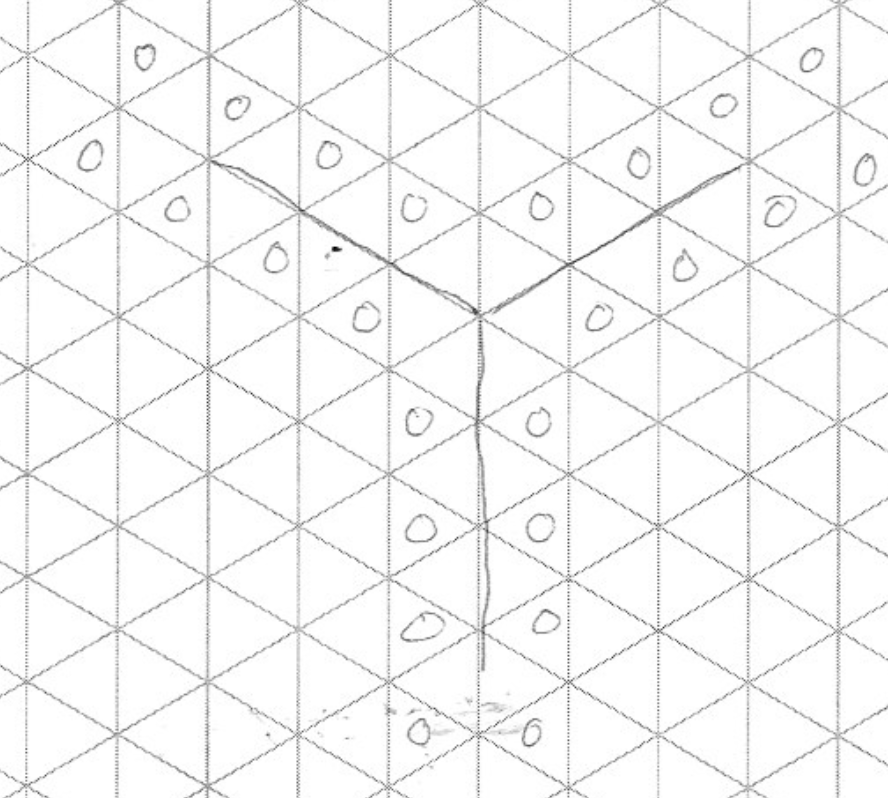
Contra dancing is usually done in long lines of dancers partitioned into groups of two couples. The dance is done with those two couples and then each couple progresses on to the next couple up or down the line. This paper describes how some, or all, two couple minor sets can be expanded to three couples, and still do the same dance with the same timing. While not for everyone, certain dancers will enjoy this twist on contra dancing.
Honeycomb Contras are another in a series of Square Games. I typically would expose dancers and callers to these ideas after midnight at Callerlab or at a dance weekend.
Quite a while ago I was exposed to what is now known as the Zia formation, where two contra lines intersect in a giant "+" shape. Dancers are instructed how the dance proceeds through the intersection, often using square dance moves. Bob Isaacs is best known for his Zia contras. See Zia Formation and especially read Zias.doc
While I found the Zia intriguing, I was dissatisfied that there wasn't a general rule that allowed every two-couple contra dance move to work in a Zia.
Earlier this year, it dawned on me that we already have such a general rule, and we use it in Hexagon dancing where we do square dances with 6 couples instead of the usual 4. Part of Hexagon dancing is Triangle dancing where we do 2-couple dancing with 3 couples.
For the rest of this paper, I will guide you through a long thought experiment. As this is being written, I have only tried this with 6 and 12 dancers and not with music.
Note: I will be assuming "normal" couples and using the terms men, women, and ladies.
Also, let's initially consider only duple improper dances that stay within their minor set, and progress as the last move.
All the contra dance moves we normally do with two couples, say from facing couples, can be done with three couples in the shape of an equilateral triangle. Every dancer has a partner and a dancer they are "facing" even if it is at a slight angle. Because you are working in a triangle, you may not end with the dancer you expect.
On a Right And Left Thru, all right pull by with the dancer they are facing and courtesy turn the dancer beside them. Note that unlike a "normal" Right And Left Thru where the dancers keep their partners, the Right And Left Thru from the triangle no longer has that effect. This will be true in many of the calls and we will deal with this "mixer" nature later.
Another common call from facing couples is "Ladies Chain". From the triangle, all 3 ladies put their right hand into a 3-hand star. But to whom do they chain? The answer can be stated several ways, all with the same result. Action around the center of the set goes for 2/3 the normal distance. So, the ladies go 1/3 instead of 1/2. This is the same as the ladies leave their man and stop at the next man.
You should see that the square thru with balances on the 1st and 3rd hands also works. It is kind of like a wrong way grand around a circle of 6. After the final pull by you are facing out but still have normal couples in a triangle.
Men Allemande Left 1 1/2 would have the 3 men go into the center with a left hand to form a 3-hand star and progress 2/3 of 1 1/2 (which equals 1 or once around). This can be thought of as leave their partner and go to the third dancer (which happens to be the dancer they started the move with).
Women Dosado 1 1/2 is tricky, at least it was the first time 6 of us tried it. I like to break the call into 3 parts: right shoulder pass thru, left shoulder un-pass thru, right shoulder pass thru. The women step into the center and right shoulder pass thru which moves them to be facing the man to their left. Then they move backward for the un-pass thru and are back-to-front with the second man. Finally, they pass thru and are facing the third man which is the one they started with. It is kind of like doing a 3-point turn in driving.
Of course, now that we know that Dosado 1 1/2 brings you back to the dancer you started with, we could dance it with the spinning flourish that is so common: the 3 women spin counter clockwise as they revolve clockwise around each other for a full revolution.
A full Hey for 4 would be danced as follows. Let's set up some flow with a Ladies Chain, ladies lead right-shoulder Hey For 4. Ladies head into the middle and off to the man 120 degrees to their left, pass them left shoulder and the men come into the middle and head off to their left. Pass that dancer left shoulder. And the whole thing repeats. What in two-couples we think of as a full Hey "over and back" becomes a full Hey that moves dancers 2 positions around the 3-couple set.
Here is a sequence of contra dance moves with simultaneous animations of two couples and three couples.
More animations, with each figure animated separately, can be found at George's Honeycomb Contra Figures page.
While I intend to introduce this idea to dancers by starting them in Triangles, the goal is to get across the general idea and get dancers familiar with the odd angles. I don't expect to make perfect triangle dancers out of them, or to have people trying to do math while dancing (e.g., 2/3 of 1 1/2 = 1). Just knowing that you have a partner and a neighbor and motion around the center goes less farther than usual (think "underachieve") is enough.

Everyone dances normal 2-couple choreography until they get to the triangle in the middle. At that point they use the 3-couple rules. Here is an animation of the Appetizer dance by Scott Higgs.
The bad news about dancing in this "Y" formation is that, for a normal length dance with 15 repetitions, dancers will encounter the triangle only once or at most twice. Maybe this will make the dance fun and interesting but I am unsure.
The first dance to introduce dancers to would be a 1,1 or a 2,2 dance. This would allow them to keep their partner and progress "through" the triangle and out a different arm. However, 0,1 or 2,1 or others would turn into mixers and may still be enjoyable given the right group of dancers and expectations.
When I get a group together, I expect to dance one "Y" to see how people react, and perhaps a second "Y" that is a mixer with a 0,2 or a 1,0 so people experience both the mixing effect and the bounce back (i.e., no progression through the triangle) effect.
How do we do the walkthru? Most dancers will be doing the walkthru with two couples and some with three couples. This has several issues to consider. For terminology, I would continue to use the same words as you would for the 2-couple version of the dance. This means phrases like "men allemande left 1 1/2, swing your neighbor" and "circle left 3/4, swing partner" even though the 1 1/2 is really 1 for those in the triangle and "partner" or "neighbor" may no longer be the partner or neighbor in the triangle.
When you do the walkthru, everyone will have been exposed to only one version of the dance (2 or 3 couple). Doing a second walkthru doesn't really solve the problem. I don't have a good solution other than hoping you have experienced dancers who are beginning to catch on, both from the initial triangle you showed them, and because doing 3-couple dancing isn't that hard. Also, having the dances progress throughout the workshop where they build on moves already used in previous dances will help.
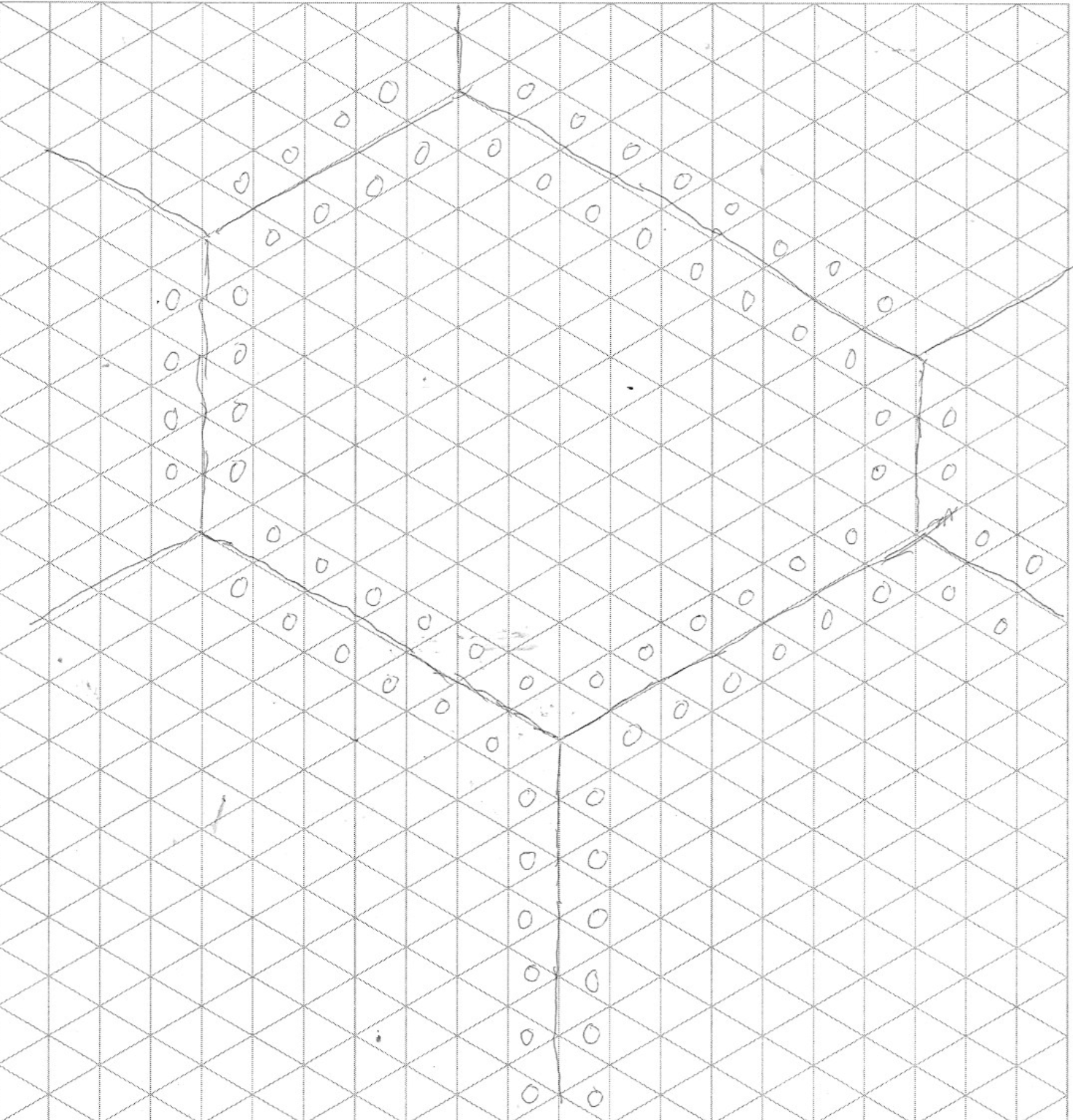
For regular shapes, think of how many 2-couple sets you want to dance before you hit the next 3-couple set. It could be 1 or 2 or more. We will cover the 0 case in the next idea. The following diagram would have the dancers alternate from 2-couple to 3-couple sets (i.e., 2 3 2 3 2 3).
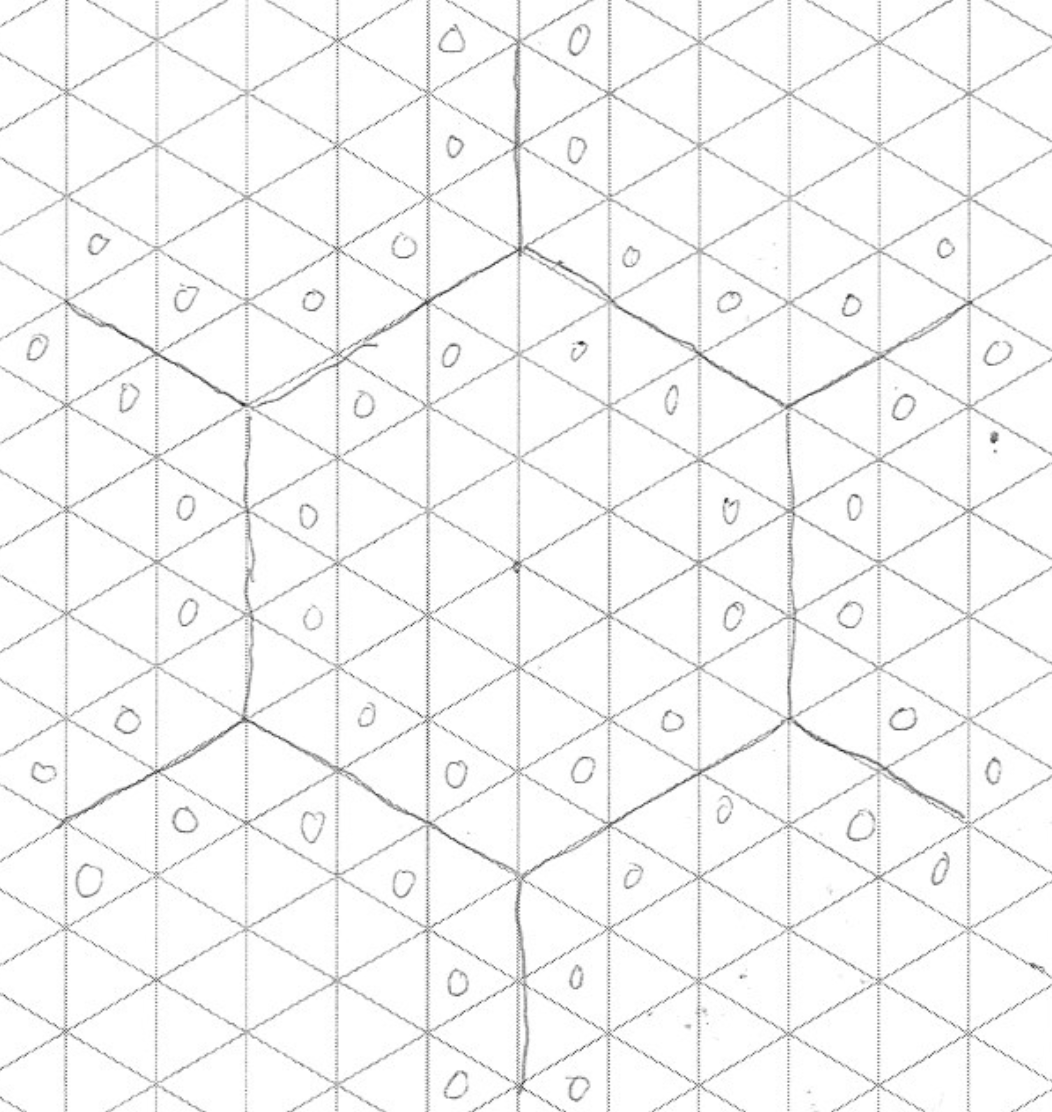
I like the idea of creating one hexagon with a "2 2 3 2 2 3" cadence in the middle of the floor and putting the remaining dancers on the 6 lines that will radiate out from that. Dance that and understand what it feels like.
Next, perhaps do it again with a "2 3 2 3 2 3" cadence and understand what that feels like.
Is one more confusing than the other? Do people mind the mixer effect? Do they like ping ponging between 2 and 3 couples or prefer the 2 2 3 2 2 3 cadence?

I expect we will want to change the dance terminology from what dancers in 2-couple experience to what the dancers will be experiencing. If the 2-couple dance has "men allemande left 1 1/2", I would change it to "men allemande exactly once, back to the same dancer...".
For dances that are mixers in 3-couple land, I expect dancers will find honeycomb contras initially really confusing. Not only are their partners and neighbors ever changing, the angles are all strange, the formation is space-filling, and it is like dancing in a giant mob. It will be very hard to recover when a mistake is made.
A single honeycomb takes 24 dancers. My goal is to get 48 dancers in a 3 honeycomb formation, dance, and see if it is fun.
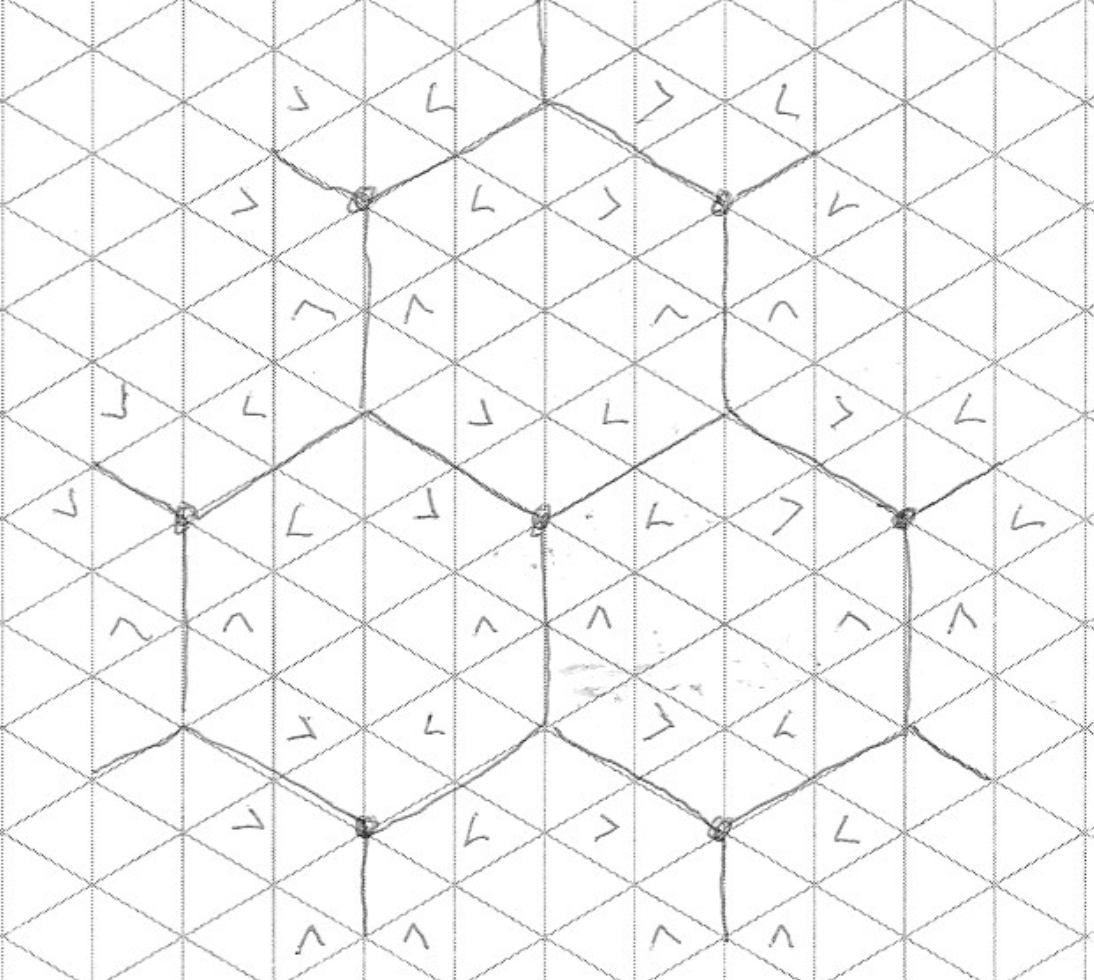
The honeycomb is space filling. I expect being in the middle of one will be very disorienting. In a normal contra dance, experienced dancers have a strong sense of:
The same could be done at a contra dance. Get 12 dancers and go somewhere where you won't be bothering anyone. Put 6 of you in a triangle, have them partner trade, and make the other 6 each face a dancer. You have created 3 very short contra lines that meet in a triangle. You will dance the following in a loop:
I would be concerned doing this at any of my local dances because it would be too obvious that we are doing something special and non-inclusive even in the back of the hall. Perhaps at a large festival like NEFFA would work better.
A long time ago, we square danced in a school with a hexagon-shaped hall! The square dancers found that disorientating. I wish that school still existed as it would be perfect for honeycomb dancing.
When I try this for the first time with a larger group of dancers, I will be prepared with some painter's tape so I can "mark the floor" where the contra lines go, especially for ideas #2, and #5.
Those going around the outside, seems more interesting, but you will be "out at the ends" more often, perhaps too often.
A Pirate's Life for Me by Nathaniel Jack
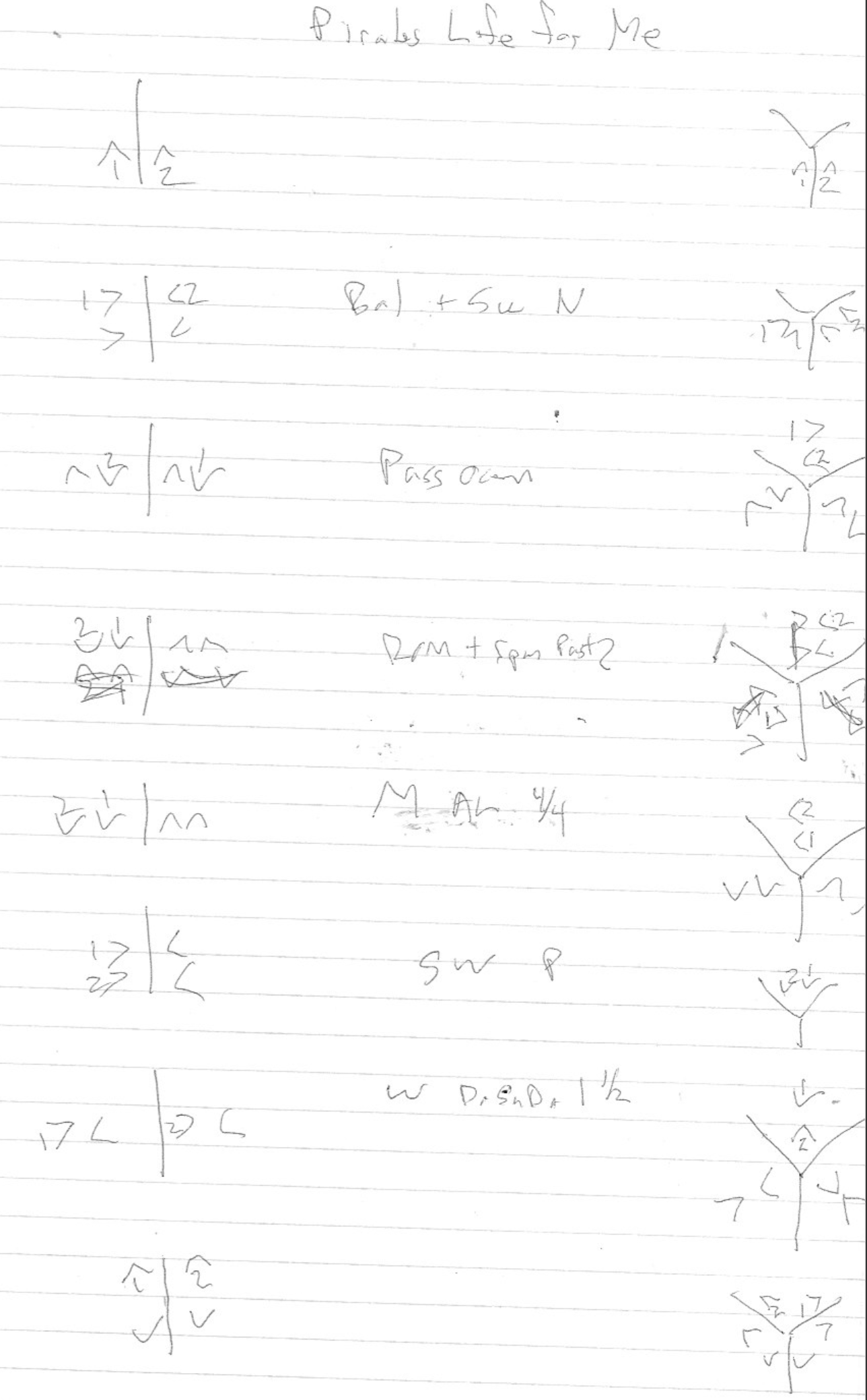
When I have diagrammed the dance, the 2-couple dancers should have progressed normally. That is, the couple on the bottom which I number man 1 and woman 2, should have moved up the page. I can then see from the diagram on the right, how my two dancers progressed. In the above dance the man progressed down the right arm of the "Y" so "2" and the women progressed down the left arm ("1") so the dance progression is "2,1" -- another mixer.
Note: While double checking my diagrams of this dance, I now see that I made a mistake on the Men Allemande Left 4/4. My diagram has them going 5/4. This shows how easy it is to make a mistake. Also, you can see where I initially got the facing directions backwards and had to scratch out some diagrams. Be careful, and double check your work. Better yet, teach a computer to dance this stuff.
Even if such a computer program existed, I highly recommend you diagram a few dances.
Sometimes it helps to see a dance in motion. For this, searching on YouTube is invaluable.
For reasons I won't go into here, it was harder than that. Instead of putting in the necessary work to perfect my "by parts" method, I have diagrammed each dance by itself and spent my time getting better at that.
If the dance has a brief foray from the minor set (e.g., Dosado someone and come back and swing partner) it will probably be fine. If it is more complex (e.g., ladies chain on the left diagonal), I need to try it with real dancers to see what they think.
The good news is that everyone lines up on the walls again -- no more crazy angles.
I would have to see some examples of Zia dances to say if they fit the mathematical model of 2-couples expanded to 4-couples. I expect the answer is "no".
| Dance | Type | Progression | Features |
|---|---|---|---|
| After the Solstice | DI | 2,0 | simple, allemande 1 1/2 |
| Airpants | DI | 0,0 | simple, allemande 1 1/2 |
| Al's Safeway Produce | DI | 0,0 | Allemandes and stars |
| Another Nice Combination | DI | 1,0 | slightly leaves minor set |
| Appetiser | DI | 2,1 | simple |
| As If | Becket | 1,1 | Ricochet Hey, Pet |
| Becky's Becket | Becket | 0,1 | Hey |
| Cool Move | Becket | 2,1 | square thru |
| Cows are Watching | Becket | 22,12 | veer left and right |
| Friday Night Fever | DI | 1,0 | square thru |
| Hocus Pocus | DI | 0,0 | 1/2 Hey |
| Hortensia's Cravat | DI | 1,0 | 1/2 Hey |
| Hotpoint Special | Becket | 11,12 | Swing thru |
| Joel's in the Kitchen | Becket | 12,20 | Pet, X Trail Thru |
| Pirates Life For Me | DI | 0,1 | ROM |
| Rolling in the Hey | DI | 1,0 | Hey |
| Round the House | DI | 0,0 | square thru |
| Square Affair | DI | 2,1 | square thru |
| The Carousel | DI | 1,1 | Full Hey |
| West by Midwest | DI | 0,1 | pass the ocean, swing thru |
Not all dancers were strong dancers. Some hadn't danced in several years. Other just weren't strong.
The room was a fine size, but a little lively acoustically. The dancers soon had a "workshop" mindset and generally were paying attention to what I was saying.
I told them the main idea, got them into triangles (I think we had 3 with a few people out), and started showing them partner, neighbor, walls, angles, and calls like Right And Left Thru and Ladies Chain. I knew my first dance had a Full Hey so we spent some time on that. I am not sure everyone ever got it. We spent a long time on Hey. It was at this point I knew we were in trouble and we were not going to get to everything I had prepared.
Had a feel of "we are all in this together".
Everyone stayed for at least 2 hours.
Most people arrived on time.
In the end we were mostly able to do Rolling In The Hey.
People seemed OK with my terminology (men, women, etc. vs. larks and robins).
People were OK dancing to recorded music and caller.
Hey is really hard, even for experienced dancers. Don't start with a dance with a Hey.
The progressions on the dances need to be simple and obvious. This was not true for either of the 2 dances we ended up doing.
Having a combination of MWSD square dancers (who also contra dance) and contra dancers caused me to use a variety of terminology that wasn't always clear to one group or the other.
Pick dances with simple end effects.
While I had painters tape, we never used it. Some dancers wish we had. Probably we should have.
Dances need to be called longer, perhaps the whole time. I picked up the mike and called when this happened.
Some dancers want to read the web page first and study the animations. I had this idea that I didn't want them to know what was coming next and how I was going to build from one idea to another in the workshop so I didn't want them "reading ahead". This was probably wrong. That said, this page is long, complex, and goes into a lot of detail. It is more aimed at callers and really interested dancers, not as a way for dancers to prepare for a Honeycomb workshop.
Dancers doing the choreography through a triangle were usually OK. However, when a weak dancer hit a triangle, any wobble was enough to bring the whole triangle down.
We know from experience that it is hard to recover from mistakes when a triangle goes down.
The few dancers who arrived later were confused for most of the workshop.
Because I am not a contra caller, and because one of the goals is that we can do Triangles and Honeycomb with existing dances and existing calling, and perhaps because of my background as a challenge dancer used to dancing to tapes of existing dances, I restricted myself to a set of pre-recorded, alternative music dance tapes Lisa and I have created. This overly restricted me to certain dances, and a mindset of "pick dances that are good with 2-couples and let's see if we can do them with 3-couples" instead of "what would give 3-couple dancers some success before we beat them down with Hey".
It took me a long time to realize that dancers were not going to get the Hey. It wasn't hard in practice (a group of 6 in my house) and it wasn't hard when I tried it with 12 MWSD dancers but it threw the group today for a loop. I should probably write a whole section on what we all learned about Hey.
Reading over the questions we wanted answered, I am sorry to say that we never got far enough in the workshop to learn any of the answers. By the end we had 14 dancers mostly succeeding in dancing Rolling In The Hey and enjoying themselves.
We are going to take away many of your unconscious crutches that make you a good dancer. For today, you need to pick a single role and stick with it.
Dance #1: Start by having them dance a normal contra for several minutes to get their bodies and minds thinking contra.
Explain a little bit about what we are going to do.
Don't use the term duple improper or giant 8 chain thru. Do use terms they are used to hearing at contra dances.
Dance #2: Form a triangle, make a giant Y around it, and show partner, neighbor, and progression, and do "Pass Thru, Trade By over and over to really get the feeling of dancing through the Y.
Do some long lines forward and back, and explain that the triangle needs the spokes to help them orientate.
All walk through the dance. Then, everyone watches the triangle do the walk thru. Try dancing and see how it goes.
Dance #3: Break everyone into triangles and walk the dance without mentioning fractions (which are off-putting and not helpful).
When everyone is good, have them line up in a giant Y, walk the dance one more time, and dance it.
Dance #4: Should use calls from the first dances and perhaps add one new move. Decide if you want to teach this move in triangles for everyone, or just have the center triangle show how it works. Do the dance in a Y.
Evaluate how the time is going and decide what to do next.
Advantages:
My "slot" at the weekend started with an unrelated 15 minutes of review and workshop on calls that had given dancers problems at the Friday night dance. This allowed people to arrive, get used to dancing this morning, especially to me. They were warmed up.
I was scheduled for a 75 minute slot. To start the Honeycomb session, I had everyone get a partner and line up in a contra line (i.e., a giant 8 Chain Thru). The line was a little long so we split into two lines. I explained that they would be dancing 2-couple Plus in these lines and that the choreography would progress them and their partner to the next group. I proceeded to call 6 or 7 sequences and all went fine and they seemed to enjoy it. Actually, I believe I started with a bad sequence that needed a Square Thru 3 changed to Square Thru 4. Oops.
Perhaps we could have spent a 10-minute tip dancing this way in long lines, and it would have been a novelty, but I had other places to go.
I next got the entire floor into 3-couple triangles, and this was an opportunity for anyone who arrived late to join in. I did a quick teach of triangle dancing. This is described in my hexagon squares paper, and many of the dancers already had experience with hexagons.
I explained to them who they were facing, who their partner was, and calls we could do. Then I went into working around the center with calls like Ladies Chain and Flutter Wheel. Next, I went to ocean waves, Swing Thru, and Spin The Top. Next up was two-faced lines and Couples Trade. Finally, we got to diamonds. From two-faced lines, have the Centers Hinge (don't go too far), Check A Diamond. This is always a surprise for those new to triangle dancing because it doesn't look at all like what you expected.
I probably spent 10 to 15 minutes explaining triangles. Next, I started calling my initial 5 to 10 sequences from these triangles. After each sequence, which left everyone facing out, I would do a partner trade.
This part of the session is critical. We need the dancers to learn and be good with triangles, but we don't want to spend all of our time there. Dancing triangles is OK, but you are stuck with the same 6 dancers, and it isn't as interesting as hexagons. I felt the dancers were good enough with triangles and it was time to move to the next step.
I told the floor we wanted several triangles with "legs" off the 3 sides. In the end I believe we created 3 such formations, and two of them were close enough to each other that two legs plus an extra couple formed a fourth triangle. This was fine.
At this point, I explained that we would do the 2-couple dancing, like before, and when you hit the triangle, it would be 3-couple dancing. Also, you may lose your partner in the triangle. I believe I started with my initial sequences again and we danced for a while. I believe the dancers were entertained and would could have done this longer, but I had more to get to.
Before I started dancing in this formation, just to make sure everyone understood the progression, especially progression in triangles (i.e., Pass Thru), I called perhaps 10 "Pass Thru, Trade By" in a row. Then I called perhaps 8 sequences,
Having stopped this, I pointed out that we had 3 triangles connected together already and that "bent" halfway around the room and if we kept adding triangles, once we had 6 it would be a closed formation. People liked the idea and we initially tried to create this with 3-couple groups alternating with 2-couple groups. While we had enough dancers, we ran out of room as our dancer hall is 6 squares wide and 2 square deep. We removed two 2-couple groups from the sides and ended up with an oval. I don't remember what we did with the left-over dancers. I expect we added them as legs to the triangles heading out of the oval.
We danced this for a bit, I don't remember how long, and I believe it was fun and we could have gone longer. However, I had more to get to.
It was here that I started to get into trouble. I believe we took out all the 2-couple sets and were left with 6 triangles in a hexagon. I don't think we did anything with this because I was looking for the 3 triangles in a triangle. I didn't know how to set it up and there was confusion on the floor with some people having ideas. In the end, I turned my laptop around and showed several "square generals" what I wanted and we started building it.
Today, we believe the better way is
In any event, after 5 to 10 minutes of chaos, we assembled most dancers into tightly packed triangles with 2-couples sets hooked onto the outside where we couldn't make more triangles. I don't remember, but I expect I did a bunch of "Pass Thru, see your new group, Pass Thru, see your new group" progressions so everyone could handle what was about to happen. Then, we danced. It was a bit stop and go to make sure everything was working. We soon noticed:
At this point I looked at the time and, expecting my time to be up, noticed that I had about 10 minutes left. I think we danced for 5 more minutes and then gave everyone a break before the next activity.
While doing the final Honeycomb, I believe I saw the following:
Observations:
Initially, I was aware of this and used Taminations to dance each sequence in 3-couple mode to record on the sequence what happened. The first 5 sequences I evaluated all were "2,1"! I looked a little deeper and discovered that Taminations had a bug. This is not surprising as what I am using it for is somewhat of a corner case. I reported the bug, Brad immediately understood and has fixed it.
Meanwhile, I just called the sequences without further progression consideration. This was a mistake. Dancers noticed any sequences with a "0" progression, especially when they were on the outside of a formation and got bounced between being out, being in for one sequence, and being out again.
Now that Brad has fixed Taminations, I need to compute the progression on all my sequences and eliminate the ones with a "0" progression, the same way we eliminate sequences with "bad flow" or "bad use of hands".
If you are a MWSD caller who wants to show this to your group, give me a call and we can talk over how to do it and the pitfalls.